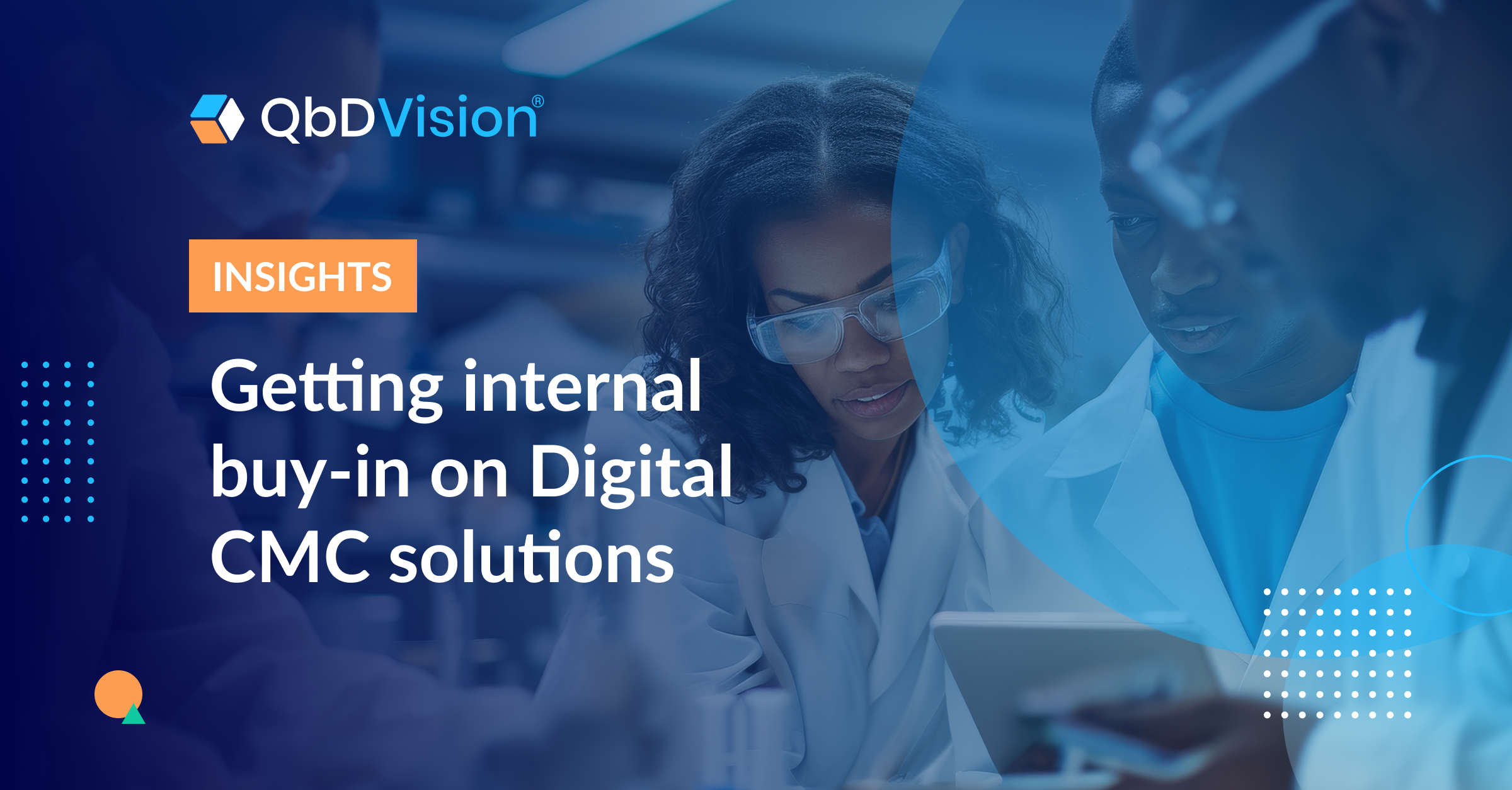You know the value of a Digital CMC platform—but how do you get leadership on board?
If you’re a drug development professional working with CMC data, you may not need to be sold on the benefits of a Digital CMC platform like QbDVision.
You already know the problems it can solve because you’ve experienced them firsthand: data scattered across the organization in isolated documents, last-minute scrambling to piece together the information needed for key deliverables, and time lost to manual data compilation and analysis.
For anyone who lives this all-too-common CMC reality, investing in a pre-commercial product lifecycle management (PLM) platform is a no-brainer. Where’s the “buy now” button??
Of course, it’s never quite that simple. Scientists, engineers, analysts, and other CMC contributors on the data frontlines might need no further convincing… but you probably know who does.
Let’s take a look at some strategies for selling the folks upstairs on Digital CMC – so you can get your team back to doing what they do best.
The prioritization problem: Why management might need some persuading
Now, there’s a good chance that your management can see that their CMC contributors are drowning in data—and maybe even how the right digital solutions would help. But the reality is that management is constantly grappling with a long list of business challenges to address, and making tough decisions about which to prioritize and when.
Scientists, engineers, analysts, and other CMC contributors on the data frontlines might need no further convincing… but you probably know who does.
So the real question often is: Why should they prioritize this particular challenge when there may be many others vying for their attention and budget? Your task: Give management a compelling answer to that question. And the best way to do that is to illustrate how the benefits of a pre-commercial PLM platform directly support their top priorities.
From accelerating the development of new products to maximizing workforce capacity and extending the organization’s CMC budget, here are the key benefits to focus on with management.
First things first: Why a Digital CMC platform—and why now?
Innovation in CMC knowledge management has never been more urgent. With the faster pace of pharmaceutical development and increased complexity of manufacturing processes, CMC data is being generated at higher volumes and faster rates than ever before. Organizations still tied to outdated, document-centric data management processes can’t keep up, and frontline teams like yours are bearing the brunt of the challenge.
Luckily, there’s a clear solution: Invest in a platform that’s built to centralize, integrate, and manage CMC data at every stage of the development cycle. And today, there are purpose-built solutions like QbDVision that do just that. They’re designed specifically for CMC workflows, allowing users to unlock a myriad of benefits:
- Unified, centralized management of product and process knowledge, at every stage of its evolution
- Accelerated reporting, regulatory submission development, and document generation
- Streamlined knowledge exchange with downstream and outsourced teams, including CDMOs, new manufacturing sites, regulators, and more
Any CMC contributor can see how PLM functions like these will help streamline workflows and save time. So how do you map those user benefits to the financial and operational impact that leadership wants to see?
Communicating the value of a pre-commercial PLM platform to management
Many management teams will be excited to learn about solutions that can help lighten their teams’ workload – but that alone may not be enough to convince them to invest. Let’s zoom in at five additional benefits you can sell them on that closely align with some of their top priorities.
Benefit #1: Protecting critical launch timelines
Before you start this conversation with your boss, let’s be real.
Yes, CMC data is often unstructured and fragmented, and yes, it frequently walks out the door in people’s heads when your workforce changes. But here’s the rub: that’s your problem. Not management’s.
Ouch, right? Your last deliverable may have taken weeks of tedious, inefficient work, but if timelines are met… well… “you really came together as a team!” As long as the outputs are on time, leadership doesn’t typically feel the pain of cobbling them together from countless sources across the organization.
But here’s what they do feel: the risk that all that inefficiency may delay their submission, push their launch date, or lead to other time-to-market “speedbumps” that boards and investors don’t want to hear about. Those risks can turn heads in the C-suite faster than you can say “bonus clawback.”
So focus there when starting the conversation about Digital CMC solutions.
It’s not just about hard-to-find, unusable data: It’s about streamlining inefficient workflows that drag out mission-critical processes, jeopardize critical milestones, and delete revenue-driving time on market. Ultimately, digital CMC solutions don’t “just” make life easier for you and your fellow scientists: they help ensure that CMC workflows flow smoothly and efficiently toward the outcomes everyone wants to see: an approved product making a difference.
Smiles across the cap table!
As long as the outputs are on time, leadership doesn’t typically feel the pain of cobbling them together from countless sources across the organization. But here’s what they do feel: the risk that all that inefficiency may delay their submission or push their launch date.
Benefit #2: Increasing team capacity
For many drug developers, the CMC status quo looks like vast amounts of data stored across all kinds of mediums: paper files, spreadsheets, email inboxes, and more. And as anyone who works with that “data” knows, the time lost to searching for it, recreating it when it can’t be found, and compiling it into something meaningful is no small matter.
Investing in a pre-commercial PLM platform means less time lost to cumbersome data-hunting expeditions, and more time spent on your highest-value activities: generating new data, analyses, and insights that can help move your CMC program forward.
Less budget-burning busywork and more high-value outputs? That will be music to management’s ears.
As long as the outputs are on time, leadership doesn’t typically feel the pain of cobbling them together from countless sources across the organization. But here’s what they do feel: the risk that all that inefficiency may delay their submission or push their launch date.
Benefit #3: Breaking down interdepartmental silos
It’s no secret that drug development is more intensely interdisciplinary than ever. Effective collaboration between R&D, regulatory affairs, manufacturing, and other teams is essential to accelerate time-to-market and avoid downstream regulatory setbacks.
The problem: Interdepartmental silos and fiercely guarded data moats. As Daniel Matlis put it in his keynote at the 2023 Digital CMC Summit, the standard data protocol in today’s CMC programs is a catapult: Pack it up, lob it over the wall, and now it’s their problem.
Now there’s a better way: pre-commercial PLM software. With real-time data sharing, integrated project management tools, and regulatory compliance tracking, a solution like QbDVision enables all stakeholders to work together cohesively. Increased visibility across teams means that key information won’t stay trapped within the team that created or manages it.
And bonus, organizations can also cut down on lengthy staff meetings: the default way to lob information across knowledge-siloed departments today.
With real-time data sharing, integrated project management tools, and regulatory compliance tracking, a solution like QbDVision enables all stakeholders to work together cohesively.
Benefit #4: Laying the groundwork for future AI use cases
As you might have heard by now, AI has the potential to unlock new value across the entire life sciences industry, CMC included. Whether it’s generative AI-powered regulatory submissions, predictive modeling of new processes and risk profiles, synthetic process design, or something else entirely, one thing is clear: The future of AI in drug development is incredibly exciting.
But here’s the catch: Those potential AI use cases require organizations to first have and then harness vast amounts of high-quality, structured data—and most CMC programs today only have the “vast amounts” part of that equation covered.
Management naturally wants to be poised and ready to reap those future AI benefits. And with Digital CMC solutions, every keystroke sends your data straight to a FAIR-based framework that’s optimized for AI utilization. The more data you produce in that framework now, the sooner you’ll be able to deploy powerful AI solutions in your CMC workflow later.
With real-time data sharing, integrated project management tools, and regulatory compliance tracking, a solution like QbDVision enables all stakeholders to work together cohesively.
Benefit #5: Reducing operational costs
So, fewer time-to-market risks, more efficient and collaborative workflows, maximized staff capacity, and accelerated AI use cases – all fantastic reasons to adopt Digital CMC solutions! But here’s the cherry on top: they can save you money and protect your budget too.
You don’t have to look far to see how. Shaving hours and weeks off critical processes can also save hundreds of hours in FTE costs – still one of the biggest overhead burdens in our industry. Streamlining regulatory submissions can help increase a team’s total output. And faster tech transfers doesn’t just mean fewer months burning budget on operational ramp-up – it means more time on market driving revenue. That’s the kind of savings that really gets management interested, and it all starts with one smart investment..
Need some numbers to back up that up? Your management definitely will. Let’s take a look at some.
Fewer time-to-market risks, more efficient and collaborative workflows, maximized staff capacity, and accelerated AI use cases – all fantastic reasons to adopt Digital CMC solutions! But here’s the cherry on top: they can save you money and protect your budget too.
Get to the digits: What’s the ROI on Digital CMC?
Newsflash for nobody: Leadership LOVES the numbers. What can it do? Okay. What can it save us or make us? Now we’re listening.
So here’s the clincher: quantifiable ROI from an investment in QbDVision. It’s some real, two-comma savings that your C-suite will love to see.
Numerical customer results
- One QbDVision user has successfully shaved 6-12 months off essential but time-consuming workflows, like tech transfers.
- Others have been able to reduce time spent on compliance reporting by as much as 95%.
- The same user has reduced key reporting timelines from 3 weeks to just 6 hours.
Projected program savings
Assuming a typical 7- to 8-year pre-commercial CMC lifecycle, we can offer a conservative estimate of the kind of savings and ROI QbDVision users can expect to see:
- 10% reduction in personnel costs, lifecycle timeline, and manufacturing costs
- Savings of $4.3 million in personnel costs and $2.2 million in manufacturing costs
- ROI of 228% over the CMC lifestyle per program
That’s not just incidental ROI: That’s the kind of cost reprieve that looks great on a quarterly or annual report, or at the next board meeting with investors. Feed management some impactful figures like these, and it can help loosen exactly the right budget strings.
But while these numbers are impressive, it’s still a good idea to expect a few hedges and questions from managers who aren’t quite ready to take the plunge. Next, we’ll cover a few questions that might come your way, and how to handle them
“Why can't you just use Excel and SharePoint?”: How to handle common objections
Fast forward: You’ve laid out a compelling case for investment in a pre-commercial PLM platform. But the work isn’t done yet. Management – like they do – has some questions and concerns about this proposed investment.
Here’s how to address any lingering doubts or concerns they may have.
“IT won’t take on any kind of major integration or deployment lift.”
Luckily for IT, QbDVision is an off-the-shelf Digital CMC solution that can be deployed from the cloud with minimal support from IT. We even partner with best-in-class cloud services from Amazon Web Services (AWS) to make the deployment process seamless.
“A cloud solution? No way that’s secure enough for our IP.”
Lots of today’s life sciences leaders still get hesitant at the thought of storing their data anywhere other than an on-prem data center. To allay their concerns, let them know QbDVision protects proprietary data with best-in-class security features:
- 256-bit encryption (transit/rest)
- GAMP5 Level 3 cloud-based software solution with serverless architecture (COTS)
- Coded with OWASP Top 10 in mind
- Static application security testing
- External penetration testing performed at least annually
- Comprehensive in-house information security management system
“Excel, PDFs, and SharePoint are still good enough for ALCOA+.”
Complying with ALCOA is obviously important: it’s still the FDA benchmark for data integrity. But ALCOA shouldn’t be an excuse to avoid changing the document-centric status quo in your compliance workflows – especially when you can now use digital tools that both meet ALCOA standards and centralize data in structured, AI-friendly formats.
When you don’t have to choose, why stick with legacy processes that have been completely overwhelmed by the volume and complexity of today’s CMC data? Shift to a solution that ensures compliance and unlocks the value of your data – simultaneously.
“Why would we share our team’s data with other departments? It's our team's data.”
Traditionally, many units have thought of their data outputs as a department resource to gate-keep – sometimes to preserve data integrity but just as often to protect departmental turf. But with today’s intensely multidisciplinary CMC workflows, that mindset no longer serves your business.
Knowledge silos slow workflows, create extra steps to exchange information, result in duplication of efforts, and lead to major data integrity issues instead of preventing them. QbDVision facilitates collaboration, provides shared visibility into key data resources, and puts up-to-date information at everyone’s fingertips.
“Product lifecycle management is for commercial products.”
There was some truth to this in the past, when CMC programs’ only options were to adapt a general PLM platform to drug development or to retrofit a commercial platform for pre-commercial workflows. Neither approach was ideally suited for earlier stages of the development cycle.
But now we can leverage purpose-built pre-commercial PLM products like QbDVision that are designed specifically for development-stage data – with all its iterations, explorations, and evolutionary steps.
“This will change our business processes too much.”
Au contraire: The bigger risk comes from sticking with the status quo. Many of those existing processes are based on a document-centric data framework that’s increasingly ill-equipped to handle the volume and complexity of CMC data.
In the long run, continued allegiance to that framework will cost the organization much more than an investment in QbDVision.
“Another point solution for [insert dept.]? No way.”
QbDVision is built to manage CMC data across the product lifecycle, and to integrate it with numerous upstream and downstream solutions. It’s not a point solution for any one department: it’s a data backbone for the entire CMC program.
Process, MSAT, Analytics, Quality, Regulatory, and more can all use it as their single source of truth, accessing and leveraging centrally managed and audit-trailed data at any time in the product life cycle.
“Maybe with the next project. We’re too far into this one.”
The longer we wait, the more we’re contributing to the problem: floods of unstructured data piling up in ways that make it extremely inefficient to work with. Plus, QbDVision features like its cloning function make it easier to start new projects based on data from previous ones.
The sooner we implement it, the sooner we can use those features to save time and avoid duplicate work.
Next up: Let us know when we can support your discussions.
If your management team is like many we’ve met, all these talking points and data points should put you on strong footing the next time you discuss a Digital CMC investment with your leadership. You don’t need good luck: You’ve got this!
Not sure how to frame these ideas for your organization and its priorities? We’re always happy to help. Tell us a little about your team, program, and CMC challenges, and we’ll give you some tips and tricks that have won over C-suites and boardrooms across the industry.
Oh, and just remember: Always ask about their kids too.
GET IN TOUCH
Tag us in whenever you’re ready.
Reach out to our team whenever you need our experts at the table for your conversations with management.



























































